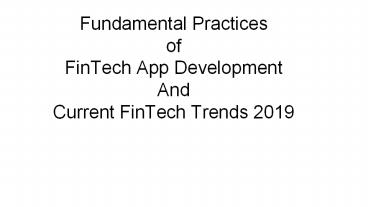Fintech Mobile App Development - PowerPoint PPT Presentation
Title:
Fintech Mobile App Development
Description:
With the development of modern technology, Fintech and mobile banking apps have become a far superior choice to traditional financial solutions. We have experienced team of Fintech app designers and developers to build highly integrative mobile apps for ios, android and web platform. – PowerPoint PPT presentation
Number of Views:804
Title: Fintech Mobile App Development
1
Fundamental Practices
of
FinTech App Development
And
Current FinTech Trends 2019
2
Index
- Fundamental Practices of FinTech App Development
- Current FinTech Trends 2019
- Our Work
- Contact Us
3
- Fundamental Practices
- of
- FinTech App Development
4
Information Security
- FinTech apps need to comply with information
security, as security is above all. The security
mechanisms should be strong with multi-factor
authentication, password security practices, and
in compliance with The Payment Card Industry
Data Security Standard (PCI DSS). For ensuring
the compliance, FinTech businesses have two
choices either they can build their own tools or
rely on third parties, whose services specialize
in identity management.
5
Eliminate OWASP 10 Vulnerabilities
- Before putting the plan of building a FinTech app
finally into action, the development team has to
scrutinize the list of OWASP (Open Web
Application Security Project) 10 vulnerabilities
through open source or proprietary tools.
6
- OWASP Vulnerabilities are
- Injection
- Broken Authentication
- Sensitive Data Exposure
- XML External Entities (XEE)
- Broken Access Control
- Security Misconfiguration
- Cross-Site Scripting
- Insecure Deserialization
- Using Components with Known Vulnerabilities
- Insufficient Logging and Monitoring
7
Financial Monitoring
- By integrating with third parties, FinTech needs
to prevent activities like smurfing, and money
laundering. It keenly monitors and looks out for
the suspicious transactions. To get a hold over
such illegal activities, FinTechs have to
establish the identity of their customers. They
can either write their own code, integrate with
third parties, or can associate with compliance
agencies. Example mobile and biometric identity
authentication apps, blockchain-based KYC, and
trade transactions solutions, etc.
8
Fraud Detection
- It is important to detect fraudulent activities.
Machine learning is a prominent tool to detect
the pattern of fraud behavior and for that
machine learning system like Generative
Adversarial Network (GAN) is used. Based on a
zero-sum game, a generator network deliberately
creates fake data, while a discriminator network
identifies between fake and authentic datasets.
Both of them learn from each other in order to
improve the results overtime
9
Create an API Call
- If you are unable to make idempotent API calls,
you can create an API call with a specific ID. In
such a scenario, if an API server fails, another
one can back it up. Even when that failed server
once recovers, the transactions will not pass
twice.
10
Stay Agile With APIs
- While designing APIs, you need to be cautious
about the confidential tech details. Do not
indulge in auto-incrementing of IDs in records.
In case of errors, dont reveal the tech details,
as the attackers may use it against you. APIs
bring in automation, flexibility and swiftness in
the workflow.
11
Microservices Architecture
- In a microservices architecture, a request passes
via different nodes in the network. It is
advisable to generate a unique ID since the
inception. So that we can trace it easily from
the very start. It provides benefits like
improved fault isolation, ease of understanding,
and it removes the vendor or technology lock-in.
12
Microservices Areas
- Today, 68 of the organizations are interested in
microservices architecture. Hence, You need to
ensure that each services should cover one
functionality. Not all at once, but organizations
have to gradually replace the monolithic
architecture by adding new microservices. The
design of microservices should be able to
withstand faults.
13
Test Coverage
- Refactoring can be cumbersome and have
consequences, so before going ahead with that you
need a good automatic test coverage. Test
coverage takes care of the quality of the test.
It can help in minimizing errors bugs, time to
market, and lastly the releases can be more
frequent.
14
Deployment of Services
- Continuous integration and delivery manages the
deployment of multiple services. Docker helps in
making the microservices portable by manifesting
standardization, while Kubernetes helps in
automating deployments, load balancing,
orchestration of containers and scaling the
resources, etc. Fintech app development teams
need to ensure over seamless logging and
monitoring mechanisms.
15
Maintaining Financial Ledger
- FinTech developers need to pay more attention to
financial ledgers. Atomicity, Consistency,
Isolation, Durability (ACID) databases can be
used to write those ledgers. Through ACID
properties, consistency is maintained in the
database with a guaranteed validity.
16
Legal Purview of FinTech
- Licencing is an essential aspect in FinTechs
which cant be ignored. Different types of
FinTech are liable to different licences, which
is an utmost important regulatory formality.
Certain bodies are looking after financial
regulations like Swiss Financial Market
Supervisory Authorities (FINMA) in Switzerland.
17
- Current FinTech
- Trends 2019
18
- Blockchain
- The most obvious yet significant reason of
involving blockchain in FinTech app development
is security. As the biggest challenge is trust.
Blockchain is cost effective and ensures safety.
As it involves blocks, a company can easily track
the entire life cycle of the financial
transactions.
19
Artificial Intelligence
- AI includes machine learning, natural language
processing, general intelligence, which delivers
personalized content, increases app productivity,
leads to automated reasoning, and helps in image
recognition. The ultimate goal is to provide
customers an exquisite user experience.
20
Quantum Computing
- It is based on Quantum theory. Quantum computing
can exponentially increase the speed of
transactions, resolve scalability issues, lower
down the processing cost and keep the financial
transactions secure. It can detect unusual
patterns in order to identify fraudulent
activities.
21
Our Work
22
Contact Us
23
- Thank You































